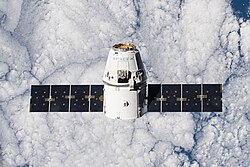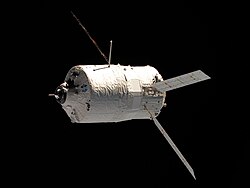Cygnus CRS Orb-3
| S.S. Deke Slayton | |||
 | |||
| Beställare | NASA | ||
|---|---|---|---|
| Uppkallad efter | Deke Slayton | ||
| Tillverkare | Orbital Sciences Corporation Thales Alenia Space | ||
| Modell | Cygnus standard | ||
| Operatör | Orbital Sciences Corporation | ||
| Uppskjutning | |||
| Startplats | MARS LP-0A | ||
| Raket | Antares 130 | ||
| Uppskjutning | 28 oktober 2014 22:22:38 UTC[1] | ||
| Kronologi | |||
| |||
Cygnus CRS Orb-3 även känd som Orbital-3, var den fjärde flygningen av företaget Orbital Sciences Corporation rymdfarkost Cygnus, den skulle leverera förnödenheter, syre och vatten till den Internationella rymdstationen (ISS). Farkosten var uppkallad efter den avlidne astronauten, Deke Slayton.[2]
Uppskjutningen gjordes med en Antaresraket den 13 juli 2014. Ungefär 15 sekunder efter start tappade Antares-raketen kraft och föll tillbaka mot marken och exploderade.
Källor
Fotnoter
- ^ Manned Astronautics - Figures & Facts Arkiverad 5 oktober 2015 hämtat från the Wayback Machine., läst 28 juli 2016.
- ^ ”ISS Commercial Resupply Services Mission (Orb-3)” (på engelska). Orbital. 22 oktober 2014. Arkiverad från originalet den 25 oktober 2014. https://web.archive.org/web/20141025024734/https://www.orbital.com/NewsInfo/MissionUpdates/Orb-3/default.aspx. Läst 20 april 2022.
| ||||||||||||||||||||||
| ||||||||||||||||||||||||||||||||
Media som används på denna webbplats
A Progress supply ship linked up to the orbiting International Space Station (ISS) at 3:48 GMT, November 18, bringing Expedition 1 commander William M. Shepherd, pilot Yuri P.
Gidzenko and flight engineer Sergei K. Krikalev two tons of food, clothing, hardware and holiday gifts from their families. The photograph was taken with a 35mm camera and the film was later handed over to the STS-97 crew members
for return to Earth and subsequent processing.Backdropped by a cloud-covered part of Earth, the Orbital Sciences' Cygnus cargo craft approaches the International Space Station, photographed by an Expedition 40 crew member. The two spacecraft converged at 6:36 a.m. (EDT) on July 16, 2014.
ISS021-E-017623 (30 Oct. 2009) --- Backdropped by a cloud-covered part of Earth, the unpiloted Japanese H-II Transfer Vehicle (HTV), filled with trash and unneeded items, departs from the International Space Station. European Space Agency astronaut Frank De Winne, Expedition 21 commander; NASA astronaut Nicole Stott and Canadian Space Agency astronaut Robert Thirsk, both flight engineers, used the station's Canadarm2 robotic arm to grab the HTV cargo craft and unberth it from the Harmony node's nadir port. The HTV was successfully unberthed at 10:18 a.m. (CDT) on Oct. 30, 2009, and released from the station's Canadarm2 at 12:32 p.m.
This image, photographed by one of the Expedition 42 crew members aboard the International Space Station, shows the SpaceX Dragon cargo craft approaching on Jan. 12 2015 for its grapple and berthing and the start of a month attached to the complex. Dragon carried more than 2 ½ tons of supplies and experiments to the station.
ISS026-E-037172 (24 Feb. 2011) --- Surrounded by the blackness of space, the European Space Agency's "Johannes Kepler" Automated Transfer Vehicle-2 (ATV-2) approaches the International Space Station. Docking of the two spacecraft occurred at 10:59 a.m. (EST) on Feb. 24, 2011.
The Orbital Sciences Corporation Antares rocket, with the Cygnus spacecraft onboard suffers a catastrophic anomaly moments after launch from the Mid-Atlantic Regional Spaceport Pad 0A, Tuesday, Oct. 28, 2014, at NASA's Wallops Flight Facility in Virginia. The Cygnus spacecraft was filled with about 5,000 pounds of supplies slated for the International Space Station, including science experiments, experiment hardware, spare parts, and crew provisions.
The Expedition 37 crew captured Cygnus with the Canadarm2 at 7 a.m. EDT Sunday, Sept. 29, 2013, and attached it to the Harmony node at 8:44 a.m.










